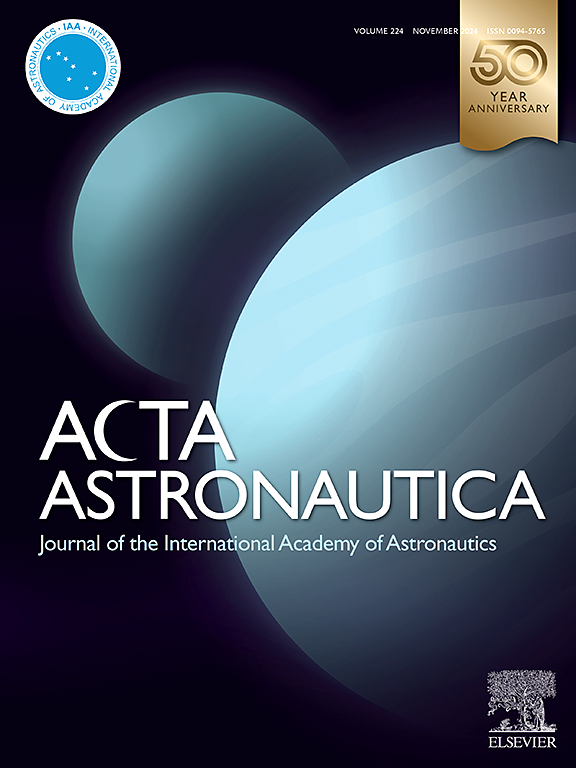Autonomous optical navigation for DESTINY+: Enhancing misalignment robustness in flyby observations with a rotating telescope
IF 3.1
2区 物理与天体物理
Q1 ENGINEERING, AEROSPACE
引用次数: 0
Abstract
is an upcoming JAXA Epsilon medium-class mission to flyby multiple asteroids including Phaethon. As an asteroid flyby observation instrument, a telescope mechanically capable of single-axis rotation, named TCAP, is mounted on the spacecraft to track and observe the target asteroids during flyby. As in past flyby missions utilizing rotating telescopes, TCAP is also used as a navigation camera for autonomous optical navigation during the closest-approach phase. To mitigate the degradation of the navigation accuracy, past missions performed calibration of the navigation camera’s alignment before starting optical navigation. However, such calibration requires capturing large number of images by the navigation camera and downlinking them to the ground station. In the case of small spacecraft with limited link capacity, such as , such ground-in-the-loop calibration requires significant operational time to complete and imposes constraints on the operation sequence. From the above background, the team has studied the possibility of reducing operational costs by allowing TCAP alignment errors to remain. This paper describes an autonomous optical navigation algorithm robust to the misalignment of rotating telescopes, proposed in this context. In the proposed method, the misalignment of the telescope is estimated simultaneously with the spacecraft’s orbit relative to the flyby target. To deal with the nonlinearity between the misalignment and the observation value, the proposed method utilizes the unscented Kalman filter, instead of the extended Kalman filter widely used in past studies. The proposed method was evaluated with numerical simulations on a PC and with hardware-in-the-loop simulation, taking the Phaethon flyby in the mission as an example. In the example case, the misalignment-induced navigation accuracy degradation of 4.6 km- can be reduced to 0.1 km- by the proposed method. The required time to run one-cycle of the navigation process on the onboard computer for the mission is less than 0.18 s. These results validate that the proposed method can mitigate the misalignment-induced degradation of the optical navigation accuracy with reasonable computational costs suited for onboard computers.
DESTINY+的自主光学导航:利用旋转望远镜增强飞掠观测中的失调鲁棒性
命运+是JAXA即将推出的Epsilon中型任务,将飞越包括Phaethon在内的多个小行星。作为小行星飞越观测仪器,航天器上安装了一台机械单轴旋转的望远镜TCAP,在飞越过程中对目标小行星进行跟踪观测。与以往使用旋转望远镜的飞掠任务一样,TCAP也被用作导航相机,在最接近阶段进行自主光学导航。为了减轻导航精度的下降,过去的任务在开始光学导航之前对导航相机的对准进行校准。然而,这种校准需要由导航相机捕获大量图像并将其下行到地面站。对于像DESTINY+这样链路容量有限的小型航天器,这种环内校准需要大量的操作时间才能完成,并且对操作顺序有约束。基于以上背景,DESTINY+团队研究了允许TCAP校准误差保留以降低操作成本的可能性。在此背景下,本文提出了一种针对旋转望远镜不对准的自主光学导航算法。在该方法中,望远镜的对中偏差与航天器相对飞掠目标的轨道同步估计。为了处理误差与观测值之间的非线性关系,该方法采用无气味卡尔曼滤波,而不是以往研究中广泛使用的扩展卡尔曼滤波。以DESTINY+任务中的Phaethon近地飞行为例,通过PC机上的数值模拟和硬件在环仿真对所提方法进行了验证。在算例中,该方法可将4.6 km-1σ的定位误差降低到0.1 km-1σ。DESTINY+任务在星载计算机上运行一个周期的导航过程所需时间小于0.18 s。实验结果表明,该方法能够有效地缓解光学导航精度的失调,且计算成本合理,适合于机载计算机。
本文章由计算机程序翻译,如有差异,请以英文原文为准。
求助全文
约1分钟内获得全文
求助全文
来源期刊

Acta Astronautica
工程技术-工程:宇航
CiteScore
7.20
自引率
22.90%
发文量
599
审稿时长
53 days
期刊介绍:
Acta Astronautica is sponsored by the International Academy of Astronautics. Content is based on original contributions in all fields of basic, engineering, life and social space sciences and of space technology related to:
The peaceful scientific exploration of space,
Its exploitation for human welfare and progress,
Conception, design, development and operation of space-borne and Earth-based systems,
In addition to regular issues, the journal publishes selected proceedings of the annual International Astronautical Congress (IAC), transactions of the IAA and special issues on topics of current interest, such as microgravity, space station technology, geostationary orbits, and space economics. Other subject areas include satellite technology, space transportation and communications, space energy, power and propulsion, astrodynamics, extraterrestrial intelligence and Earth observations.
 求助内容:
求助内容: 应助结果提醒方式:
应助结果提醒方式:


